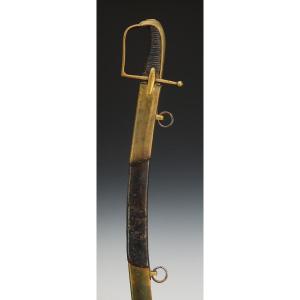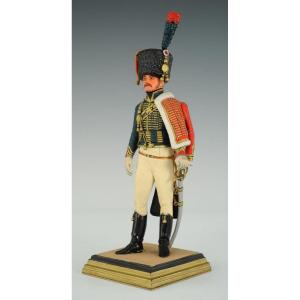Oval-shaped miniature H 11 cm, W 8.5 cm (at sight). Watercolor and gouache on vellum. It represents the full-time officer in full dress dress entirely in white cloth, piping, lapels, facings and turn-ups in crimson-coloured velvet. Straight stand-up piped collar. Buttoning right on the chest. The front is trimmed with two crimson velvet lapels with ten false buttonholes in gilt trimmings braid, gilt uniform buttons. Crimson velvet facings and piping of the same color edged with a braid and two false buttonholes similarly to the lapels. Pair of epaulettes in golden trimmings, made up of a counter-epaulette (without fringe) and one with flexible fringes called "strings with wells". White calfskin baldric with gold-mounted sword. The officer wears his black patent leather helmet with gold trimmings, front plate with fleur-de-lis and numeral "I", black mane and white plume. In the background is painted a scene of a military camp. Signed and dated lower right "OSMONT Henry pixi 80" (1780). Gilded brass frame, bedside coaster in a blackened wooden bowl frame, H 21.8 cm, width 17.8 cm.
France.
Former Monarchy, reign of Louis XVI, around 1786-1789.
Very good state.
PROVENANCE: Former Bernard Franck then Raoul and Jean Brunon collection. In his book "Ideal lived" Jean Brunon writes about the Bernard Franck collection "In my time, the two most important collectors of military memorabilia were first André Lévy and a little later, Doctor Polaillon. There was a third, Bernard Franck, but his collection, large in quantity, was partly inferior in quality. … I knew these characters at the end of the 1920s. Bernard Franck, owner of a large military supply company, died shortly afterwards and the importance of his collections was such that sales at the Hôtel Drouot were staggered for several years, each session offering varied pieces, composed of real or fake. … The most astonishing set in quantity consisted of several hundred miniatures, almost all, of course, of the Republic and the Empire. The vast majority of these miniatures were, alas, the work of copyists or even artists, of whom Bernard Franck was the dream client, because their imagination could run free, assured that they were of finding in this unconcerned amateur, a enthusiastic buyer. One wonders what has become of these “wonders”. Some miniatures were from the Louis XVI period, all of them authentic. ".
NOTE: Representations of men of the Colonel regiment are rare. HISTORY: The Colonel General regiment is an infantry regiment of the kingdom of France, created in 1480 from the bands of Picardy, the oldest military unit, and one of the five Petits Vieux, which became the 1st regiment during the Revolution. line infantry. Creation and different denominations October 9, 1480: Creation of the bands of Picardy. May 29, 1569: Creation of the Sarrieu regiment. 1585: Takes the name of Regiment of Picardy. 1780: Takes the name of regiment Colonel General, the title of regiment Colonel General. The King had just restored, by an ordinance dated April 5 of this year, the office of Colonel General of the Infantry in favor of the Prince of Condé. 1791: Becomes the 1st line infantry regiment formerly Colonel General. The office of Colonel General of the infantry in favor of the Prince of Condé. The regiment, in its capacity as the first corps of the line infantry, became the property of the Colonel General and was charged with guarding his flag. The regiment Colonel General's flag of Ordinance, like its Colonel flag, bears the Latin motto Praetriti fides exemplum que futuri, which means "fidelity to the past, example for the future". The regiment was in garrison at Le Havre in 1781, at Lille in 1782, at Besançon in 1784, at Schelestadt in 1785, at Toul in 1787, and again at Lille in 1788.







































 Le Magazine de PROANTIC
Le Magazine de PROANTIC TRÉSORS Magazine
TRÉSORS Magazine Rivista Artiquariato
Rivista Artiquariato